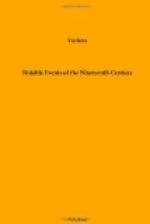The near agreement of this row of results with the row containing the actual relative distances of the planets from the sun may well astonish, not only the astronomer, but the common reader. Those distances—making 10 to represent the distance of the earth—are as follows:
Mercury, 3.9; Venus, 7.2; Earth, 10; Mars, 15.2; Asteroids, 27.4; Jupiter, 52; Saturn, 95.4; Uranus, 192; Neptune, 300.
In addition to Kepler’s prediction and the indications of Bode’s Law, there was a general reason for thinking that a planetary body of some kind should occupy the space between the orbits of Mars and Jupiter. The mean distance of Mars from the sun is about 141,500,000 miles; that of Jupiter, is about 483,000,000 miles. The distance from one orbit to the other is therefore about 341,500,000 miles. Conceive of an infinite sheet of tin. Mark thereon a centre for the sun. Measure out a hundred and forty millions of miles, and with that radius strike a circle. From the same centre measure out four hundred and eighty-three millions of miles, and with that radius strike a circle. Cut out the sheet between the two circles, and the vast space left void will indicate the vacant area in the mighty disc of our solar system. That this space should be occupied with something accords with the plan of nature and the skill of the Builder.
So Olbers and his twenty-three associates began, in the last decade of the eighteenth century, to search diligently for the verification of Kepler’s prediction and the fulfillment of Bode’s Law. Oddly enough, Piazzi was not one of the twenty-four astronomers who had agreed to find the new world. He was exploring the heavens on his own account, and in doing so, he found what the others had failed to find, that is, the first asteroid.
The body discovered answered so little to the hopes of the astronomical fraternity that they immediately said within themselves: “This is not he; we seek another.” So they continued the search, and in a little more than a year Olbers himself was rewarded with the discovery of the second of the planetoid group. On the twenty-eighth of March, 1802, he made his discovery from an upper chamber of his dwelling in Bremen, where he had his telescope. On the night in question he was scanning the northern part of the constellation of Virgo, when the sought-for object was found. This body, like the first of its kind, was very small, and was found to be moving from west to east in nearly the same orbit as its predecessor.
Here then was something wonderful. Olbers at once advanced the hypothesis that probably the two bodies thus discovered were fragments of what had been a large planet moving in its orbit through this part of the heavens. If so there might be—and probably were—others of like kind. The search was at once renewed, and on the night of the first of September, 1804, the third of the asteroid group was found by the astronomer Hardy, of Bremen.




